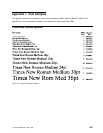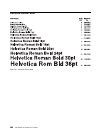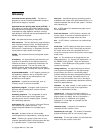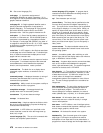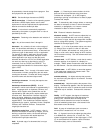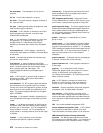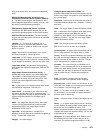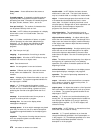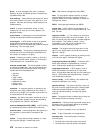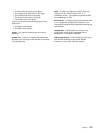be presented to internal storage from a program. See
also
physical file
and
logical file
.
DBCS. See
double-byte character set (DBCS)
.
DBCS conversion. A function of the operating system
that allows a DBCS display station user to enter
alphanumeric data and request that the alphanumeric
data be converted to double-byte data.
default. A value that is automatically supplied or
assumed by the system or program when no value is
specified by the user.
diagnostic. Pertaining to the detection and isolation of
an error.
digit. Any of the numerals from 0 through 9.
document. Any collection of text or other strings of
data. All documents and folders on a single AS/400
system make up the document library. A document can
contain any type of data stored in it by an application.
For example, the &ofcv. application can store notes,
memos, reports, and other items; the &pcs. shared
folders application can store any data that could
otherwise be stored in a PC file; an AS/400 application
can store any data into a document by using CL
commands, such as FILDOC and RPLDOC. The
system-recognized identifier for the document object
type is *DOC.
document name. The 1- through 12-character name
for documents in folders, assigned by the user when
creating the document. Contrast with
library-assigned
document name
and
document object name
.
double-byte character. An entity that requires two
character bytes.
double-byte character set (DBCS). A set of
characters in which each character is represented by 2
bytes. Languages such as Japanese, Chinese, and
Korean, which contain more symbols than can be
represented by 256 code points, require double-byte
character sets. Because each character requires 2
bytes, the typing, displaying, and printing of DBCS
characters requires hardware and programs that
support DBCS. Four double-byte character sets are
supported by the system: Japanese, Korean, Simplified
Chinese, and Traditional Chinese. Contrast with
single-byte character set
.
double-byte coded font. In AFP support, a font in
which the characters are defined by 2 bytes: the first
defining a coded font section, the second defining a
code point. Synonymous with double-byte font.
Contrast with
single-byte coded font
.
draft. A printed copy of a document that is not yet
completed.
duplex. (1) Pertaining to communications in which
data can be sent and received at the same time.
Contrast with
half-duplex
. (2) In AFP support,
pertaining to printing on both sides of a sheet of paper.
Contrast with
simplex
.
edit. To interactively add, change, delete, or rearrange
the data; for example, to insert or remove characters,
sentences, or paragraphs, or to insert or remove
characters in dates or decimal numbers.
EIA. Electronic Industries Association.
electronic overlay. An AFP resource object that is a
collection of predefined data, such as lines, shading,
text, boxes, or logos, that can be merged with variable
data on a page while printing. The system-recognized
identifier for the object type is *OVL.
element. (1) In a list of parameter values, one value.
(2) Either a bar or a space in a bar of a bar code.
(3) In AFP Utilities, the smallest unit, such as text, an
image, or a bar code, used to design an AFP resource
like an electronic overlay. See also
element mark
and
element name
.
element mark. In AFP Utilities, a mark that is used to
show the position of an element on a display; for
example, '*B005' where B means bar code and 005 is
the fifth element. See also
element
and
element name
.
element name. In AFP Utilities, a name that appears
in the image area instead of an element mark. See
also
element
and
element mark
.
exclude authority. An object authority that prevents
the user from using the object or its contents. Contrast
with
all authority
.
extended help. Help that explains the purpose of the
display. Extended help appears if the user presses the
Help key when the cursor is outside the areas for which
contextual help is available. Contrast with
contextual
help
.
fidelity. In AFP support, the degree of exactness
required when processing the input data stream for
printing a file. Different levels of fidelity can be
specified, which determine how errors are handled
(such as substituting fonts when a font named in the
data stream cannot be found).
field. A group of related bytes (such as name or
amount) that is treated as a unit in a record.
file. (1) A generic term for the object type that refers
to a database file, a device file, or a save file. The
system-recognized identifier for the object type is *FILE.
(2) In the hierarchical file system, a piece of related
information (data), such as a document.
Glossary 471





